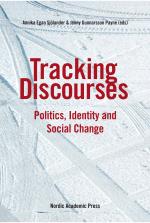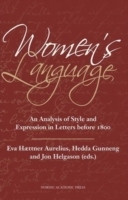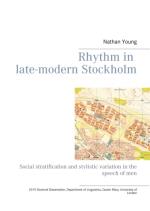Engelska
Mest sålda

-
Title:
Tracking Discourses - Politics, Identity And Social Change
-
Reviews:
-
Release Date:
-
Genre:
- Språk
-
Format:
Bok
-
Availability:
Beställningsvara Leveranstid: från 3 vardagar
-
Description:
Discourse Theory (DT) and Critical Discourse Analysis (CDA) are theoretical traditions that have gained intense research interest in recent decades. Both are concerned with critical studies of politics, identity, and social change with a focus on issues of power and language, yet the dialogue betwe...
Discourse Theory (DT) and Critical Discourse Analysis (CDA) are theoretical traditions that have gained intense research interest in recent decades. Both are concerned with critical studies of politics, identity, and social change with a focus on issues of power and language, yet the dialogue between DT and CDA scholars has been negligible until only recently.<br/><br/>In Tracking Discourses Politics, Identity and Social Change, twelve researchers explore the opportunities presented by an increased exchange of ideas between the two traditions. The authors examine what closer collaboration could offer, both theoretically and empirically, in an interdisciplinary context. The Scandinavian reception, development, and use of DT and CDA are presented for the first time in a concise way.<br/><br/>The studies in Tracking Discourses are of pivotal interest to the practical application of theoretical concepts and the empirical analysis of specific discourses based on one or both of the analytical perspectives. The case studies presented are valuable sources for comparison with similar research undertaken in other countries and contexts.<br/><br/>Contributors:<br/><br/>Sara Carlbaum, Umeå University<br/><br/>Annika Egan Sjölander, Umeå University<br/><br/>Stephanie Faye Hendrick, Umeå University<br/><br/>Jenny Gunnarsson Payne, Södertörn University<br/><br/>Joakim Isaksson, Umeå University<br/><br/>Anna Johansson, Umeå University<br/><br/>Alon Lischinsky, Umeå University<br/><br/>David Payne, University of Essex, UK<br/><br/>Anna Sofia Lundgren, Umeå University<br/><br/>Jonathan Ngeh, Umeå University<br/><br/>Angelika Sjöstedt Landén, Umeå University & Mid Sweden University<br/><br/>Mathias Sylwan, Umeå University & University of Gävle

-
Title:
Women's Language - An Analysis Of Style And Expression In Letters Before 1800
-
Reviews:
-
Release Date:
-
Genre:
- Språk
-
Format:
Bok
-
Availability:
Beställningsvara Leveranstid: från 3 vardagar
-
Description:
Is there a special niche reserved for womens language? This is the theory tested empirically by the authors of Womens language, by means of an exhaustive stylistic analysis of a voluminous body of letters written in five different languages Latin, English, German, French, and Swedish from medieval ...
Is there a special niche reserved for womens language? This is the theory tested empirically by the authors of Womens language, by means of an exhaustive stylistic analysis of a voluminous body of letters written in five different languages Latin, English, German, French, and Swedish from medieval times through to the long eighteenth century. In a detailed investigation of style and expression, the authors have applied a number of advanced methods of study to pinpoint how women expressed themselves to other women and whether they addressed themselves differently to men. Unveiling fascinating differences in language use, but none particular to female language, this authoritative work is a joy to follow for anyone interested in language, literature, stylistic analysis, and gender studies. Finns det ett särskilt kvinnorum i språket? Denna teori prövas empiriskt av författarna till Womens Language. Genom att utförligt analysera stil och uttryck i en omfattande samling brev (cirka 1 300 brev), skrivna på fem olika språk latin, engelska, tyska, franska och svenska från medeltid till och med 1700-talet, prövas här denna teori. För att komma åt hur kvinnor uttryckte sig när de skrev till kvinnor liksom för att undersöka om de uttryckte sig annorlunda när de skrev till män, samt, primärt som jämförelsematerial, hur män skrev till män eller män skrev till kvinnor, har författarna i denna synnerligen detaljerade undersökning av stil och uttryck använt sig av flera avancerade metoder. De kan visa på flera intressanta skillnader i språkbruket i kvinnors brev till kvinnor jämfört med de andra breven i de enskilda språken. Men teorin om ett särskilt kvinnligt språk oberoende av tid och rum, har inte verifierats. Detta kvalificerade arbete är en glädje att läsa för alla som är intresserade av språk, litteratur, stilanalys och genusforskning.

-
Title:
Rhythm In Late-modern Stockholm - Social Stratification And Stylistic Varia
-
Reviews:
-
Release Date:
-
Genre:
- Språk
-
Format:
Bok
-
Availability:
Beställningsvara Leveranstid: från 14 vardagar
-
Description:
Stockholm, an iconically late-modern city, is home to Europe's first-known multiethnolect - Rinkeby Swedish. Swedish-language researchers describe the variety as staccato, but rhythm has not been thoroughly investigated for any variety of Stockholm Swedish to date. Not only does this study show tha...
Rhythm In Late-modern Stockholm - Social Stratification And Stylistic Varia Bok
Stockholm, an iconically late-modern city, is home to Europe's first-known multiethnolect - Rinkeby Swedish. Swedish-language researchers describe the variety as staccato, but rhythm has not been thoroughly investigated for any variety of Stockholm Swedish to date.<br/>Not only does this study show that rhythm stratifies in the direction of staccato (low alternation) for the racialized working class, rhythm is also significantly high-alternation/non-staccato in the speech of the white working class. The former is interpreted to be a feature of multiethnolect; the latter a feature of Södersnack, Stockholm's industrial-era working-class variety. The higher classes produce an intermediate degree of rhythm in casual speech.<br/>Working-class formal speech appears to target upper-class casual speech. Within the racialized working class, a generational difference was found. Those born before 1983 mainly achieve staccato with a reduction of accented vowels. Those born after 1983 achieve it by enlarging unstressed vowels. The change point coincides with significant socio-historical transformations that occurred when the speakers were in adolescence.<br/>In all styles, younger speakers of any background have more staccato speech than older speakers of the same background. It is proposed that this is due to the diffusion of contact prosody, for which multiethnolect is one key conduit.
Utvalt - Engelska
Rhythm In Late-modern Stockholm - Social Stratification And Stylistic Varia
Stockholm, an iconically late-modern city, is home to Europe's first-known multiethnolect - Rinkeby Swedish. Swedish-language researchers describe the variety as staccato, but rhythm has not been tho...
- Populärt
- Mest sålda
- Mest bokade
- Senast släppta
- Kommande
- Pris
- A-Ö
- Välj
- 0 - 9
- A
- B
- C
- D
- E
- F
- G
- H
- I
- J
- K
- L
- M
- N
- O
- P
- Q
- R
- S
- T
- U
- V
- W
- X
- Y
- Z
- Å
- Ä
- Ö
- Övrigt

